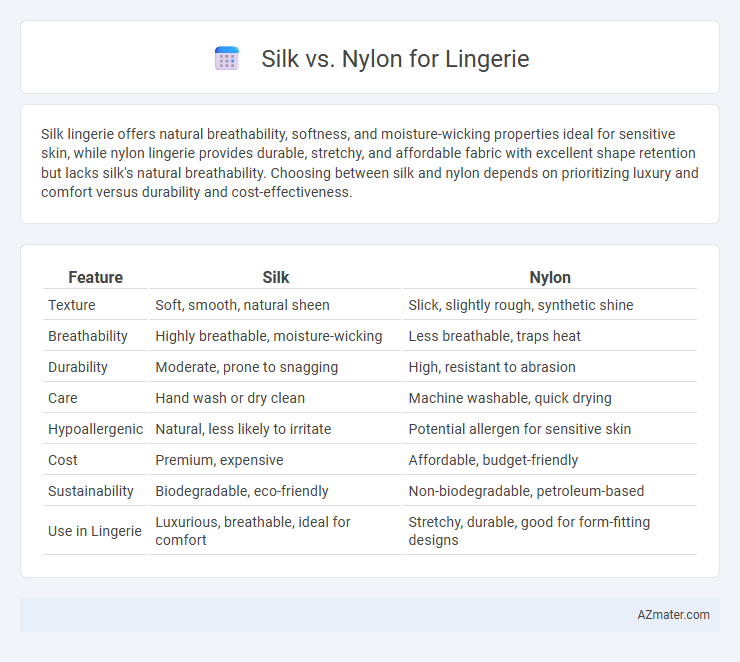Silk lingerie offers natural breathability, softness, and moisture-wicking properties ideal for sensitive skin, while nylon lingerie provides durable, stretchy, and affordable fabric with excellent shape retention but lacks silk's natural breathability. Choosing between silk and nylon depends on prioritizing luxury and comfort versus durability and cost-effectiveness.
Table of Comparison
| Feature | Silk | Nylon |
|---|---|---|
| Texture | Soft, smooth, natural sheen | Slick, slightly rough, synthetic shine |
| Breathability | Highly breathable, moisture-wicking | Less breathable, traps heat |
| Durability | Moderate, prone to snagging | High, resistant to abrasion |
| Care | Hand wash or dry clean | Machine washable, quick drying |
| Hypoallergenic | Natural, less likely to irritate | Potential allergen for sensitive skin |
| Cost | Premium, expensive | Affordable, budget-friendly |
| Sustainability | Biodegradable, eco-friendly | Non-biodegradable, petroleum-based |
| Use in Lingerie | Luxurious, breathable, ideal for comfort | Stretchy, durable, good for form-fitting designs |
Introduction: Silk vs Nylon Lingerie
Silk lingerie offers natural breathability, softness, and hypoallergenic properties, making it ideal for sensitive skin and luxurious comfort. Nylon lingerie, made from synthetic fibers, provides durability, elasticity, and affordability, often featuring moisture-wicking and quick-drying qualities. Each fabric caters to different preferences, balancing sensuality, performance, and maintenance needs in intimate apparel.
Understanding Silk: Properties and Benefits
Silk lingerie is prized for its natural protein fibers, which provide exceptional softness, breathability, and moisture-wicking properties, making it ideal for sensitive skin. The hypoallergenic nature of silk reduces irritation and offers temperature-regulating benefits, keeping wearers cool in summer and warm in winter. Unlike synthetic fabrics, silk's smooth texture minimizes friction, enhancing comfort and the luxurious feel of intimate apparel.
Exploring Nylon: Features and Advantages
Nylon lingerie offers exceptional durability, elasticity, and resistance to abrasion, making it ideal for everyday wear and active use. Its lightweight and moisture-wicking properties ensure comfort and breathability, reducing irritation and maintaining freshness. Nylon also supports vibrant colors and patterns, providing versatile aesthetic options without compromising fabric strength or smoothness.
Comfort Comparison: Silk vs Nylon
Silk lingerie offers superior breathability and natural moisture-wicking properties, making it exceptionally comfortable for all-day wear, especially for sensitive skin. Nylon lingerie, while durable and elastic, tends to trap heat and lacks the softness of silk, which can lead to discomfort during prolonged use. For optimal comfort, silk is preferred due to its hypoallergenic and lightweight characteristics, whereas nylon is better suited for budget-friendly and high-stretch lingerie pieces.
Durability and Longevity
Silk lingerie offers a luxurious feel but requires delicate care, making it less durable compared to nylon. Nylon fabric is highly resistant to wear and tear, providing long-lasting lingerie that withstands frequent washing and daily use. The synthetic fibers in nylon ensure greater longevity, while silk's natural fibers, though elegant, are more prone to damage over time.
Breathability and Moisture Management
Silk lingerie offers superior breathability due to its natural protein fibers that allow air circulation and wick moisture away from the skin, keeping the body cool and dry. Nylon, a synthetic material, provides less breathability and tends to trap heat and moisture, which can lead to discomfort during extended wear. When prioritizing moisture management and skin comfort, silk lingerie is the optimal choice for its natural ability to regulate temperature and reduce sweat accumulation.
Care and Maintenance Requirements
Silk lingerie requires delicate hand washing with mild detergent and air drying to preserve its natural fibers and sheen, while nylon is more durable, allowing machine washing on gentle cycles and quicker drying times. Silk's protein-based fibers are sensitive to heat and harsh chemicals, necessitating extra care to prevent damage and color fading. Nylon lingerie offers greater resistance to stretching and color retention, making it easier to maintain with less stringent care routines.
Cost Differences: Silk vs Nylon
Silk lingerie often carries a higher price point due to the labor-intensive harvesting and natural production processes, making it a premium fabric choice. Nylon lingerie, produced synthetically, is significantly more affordable and widely available, appealing to budget-conscious consumers. Cost differences arise not only from raw material expenses but also from durability and care requirements, with silk demanding delicate handling that can influence long-term value.
Hypoallergenic and Skin Sensitivity
Silk lingerie is highly favored for its natural hypoallergenic properties, making it an excellent choice for sensitive skin as it resists dust mites, mold, and mildew. Nylon, being a synthetic fiber, may cause irritation or allergic reactions in individuals with delicate skin or sensitivities due to its chemical manufacturing process. Choosing silk over nylon can significantly reduce skin irritation and improve comfort for those prone to allergies or dermatological concerns.
Choosing the Best Fabric for Your Lingerie
Silk offers exceptional softness, breathability, and a natural sheen that enhances comfort and luxury in lingerie, making it ideal for sensitive skin and special occasions. Nylon, known for its durability, elasticity, and moisture-wicking properties, provides a more affordable and practical option suitable for everyday wear and active lifestyles. Balancing aesthetic appeal and functional needs is essential when choosing between silk and nylon for your lingerie collection.

Infographic: Silk vs Nylon for Lingerie
 azmater.com
azmater.com